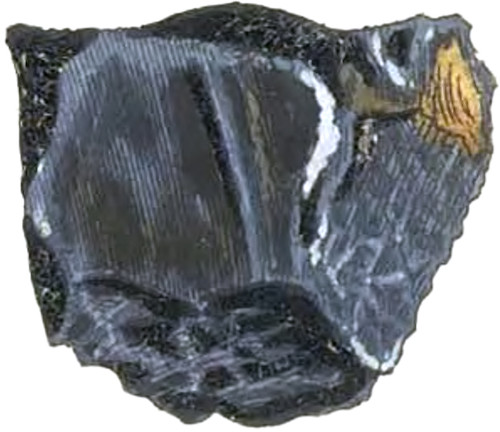 Enlarge
Enlarge
Exotic Mineralogy
Columbate of Iron, or Columbite
- Syn. Phil. Trans. 1802. 49.
Columbium is well known to have been discovered by Mr. Hatchett, in the analysis of an ore said to be from America, in 1801, which that great chemist found in the British Museum, and till the accurate Dr. Wollaston found the Tantalum of Ekeberg to be the same substance it was altogether unique. It was part of Sir Hans Sloane’s Collection, and in his Catalogue is described as “a very heavy black stone with golden streaks,” and appeared to have been sent with various sjjecimens of iron ores by Mr. Winthorp of Massachusefs. The Tantalum of Ekeberg was from Kmilo in Finland, and had been long known, but was said to be mistaken for an ore of Tin.
Our figure, by the kind leave of the Trustees of the British Museum, is taken from the valuable and original specimen, and while it evinces in some measure the knowledge of the subject in Sir Hans Sloane’s time, it is a monument of the penetration of one of the ablest chemists of the present day.
Mr. Hatchett, in his analysis, obtained from 200 grains of this mineral about 42 Brown Oxide of Iron and 155 Columbic Acid.
According to Dr. Wollaston, to use his own words, “the Columbite is so like Tantalite that it is extremely difficult to discern a difference that can be relied upon. The exterual surface as well as the colour and lustre of the fracture are precisely the same; but Columbite breaks rather more easily with a blow, and the fracture of it is less uniform, appearing in some parts irregularly shattered; nevertheless, when the two are rubbed against each other the hardness appears to be the same, and the colour of the scratch has the same tint of very dark brown. By analysis also the bodies are found to consist of the same three ingredients; a white oxide combined with Iron and Manganese. The products obtained from five grains of Columbite after each had been heated to redness were nearly
| grs. | |
|---|---|
| White Oxide of Columbium | 4 |
| Oxide of Iron | 03/4 |
| Oxide of Manganese | 01/4 |
but it cannotbc supposed that proportions deduced from experiments made on so small a scale can be entirely depended upon, although the properties of bodies maybe so discerned, nearly as well as when larger quantities are employed.”—See Phil. Trans. 1809, part 2.
Spec. Grav. according to Mr. Hatchett, 5.918.
Dr. Wollaston had not a sufficient quantity to ascertain the degree of oxygenizement of the Columbium, and we regret that he has not explained the cause of the different results he has obtained in some of his experiments from those Mr. Hatchett has described.
We are the more happy in presenting this figure, as there is no chance of another specimen, and as it will be an help to the discovery of the substance by comparison.

